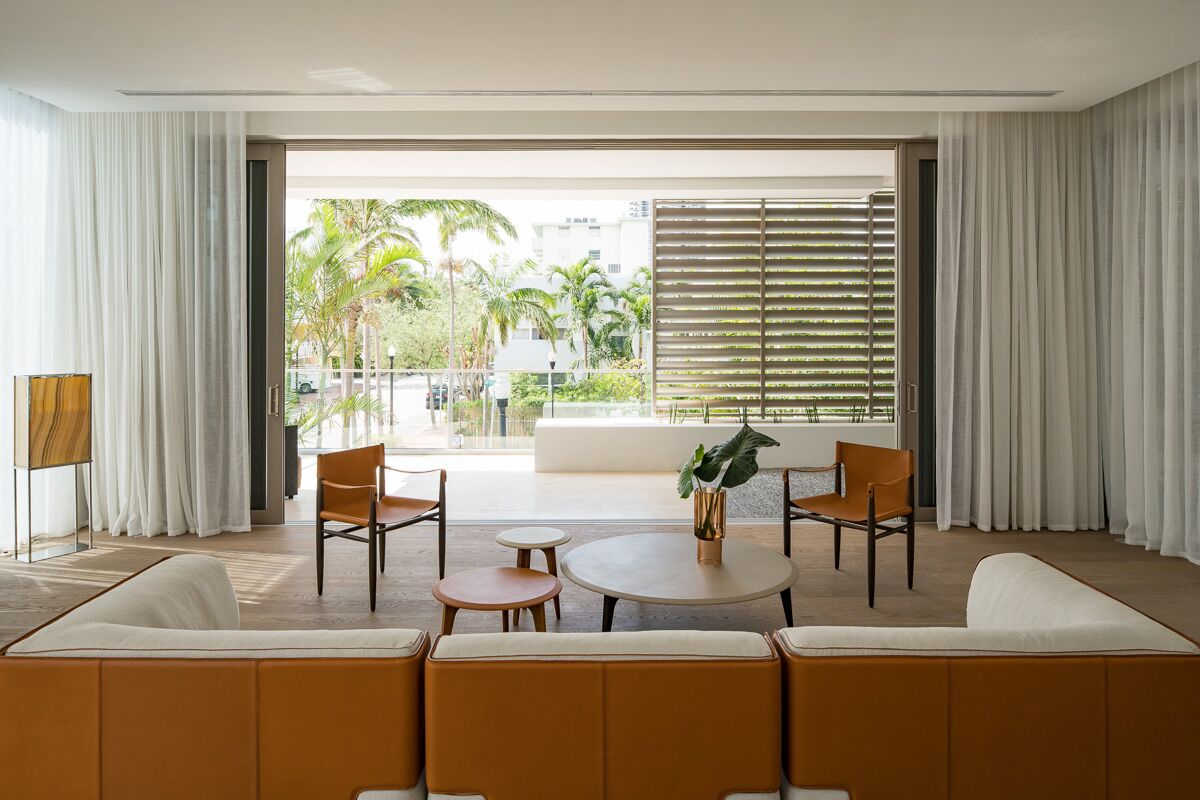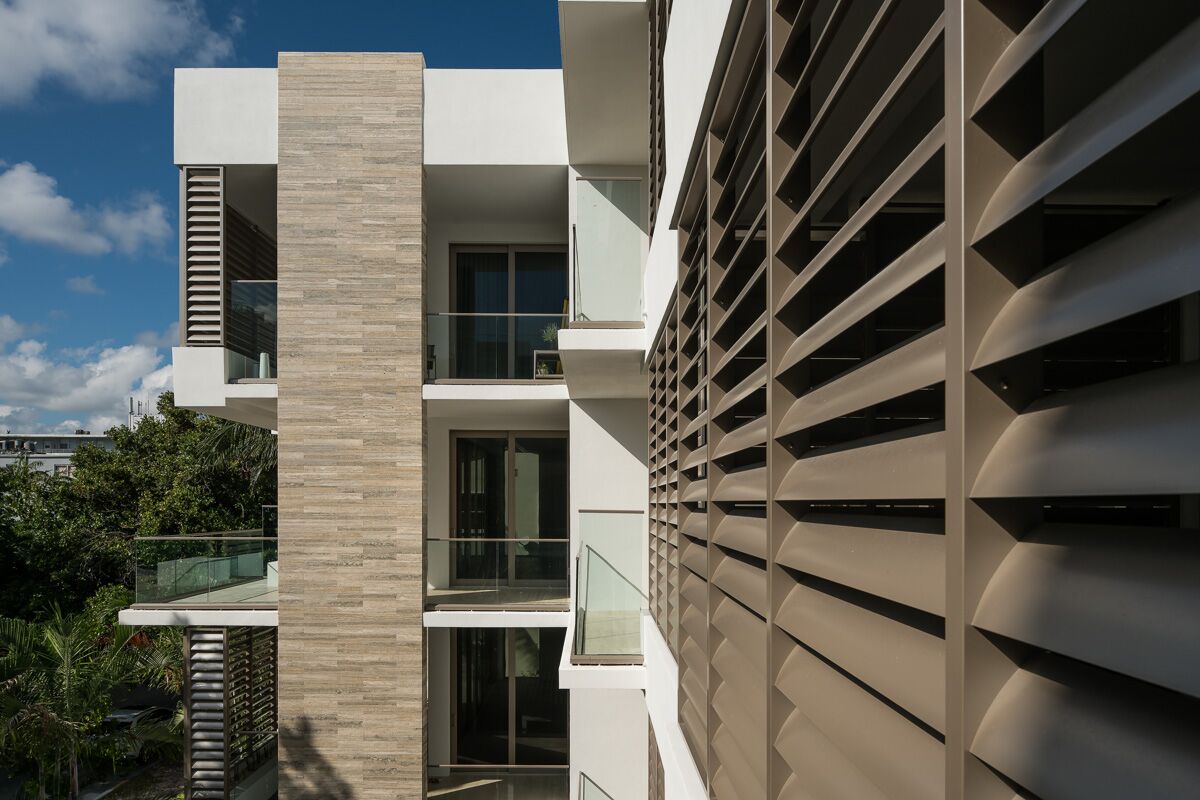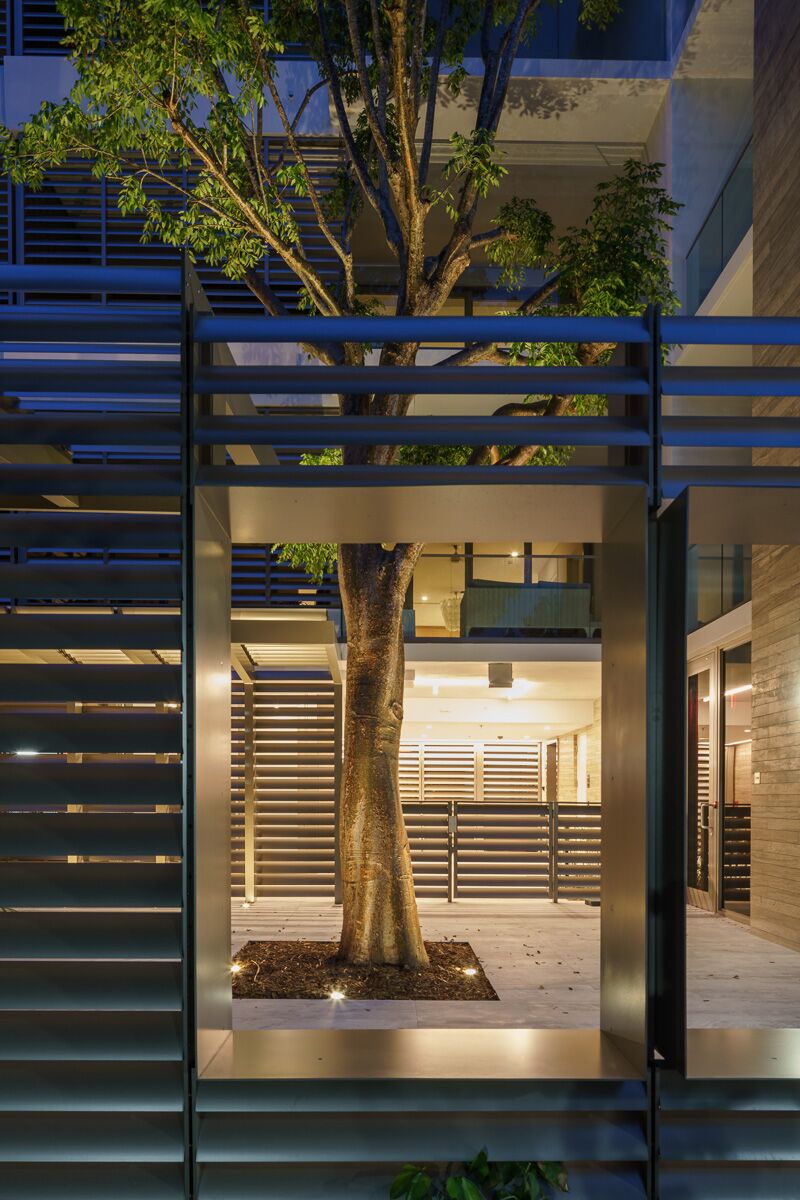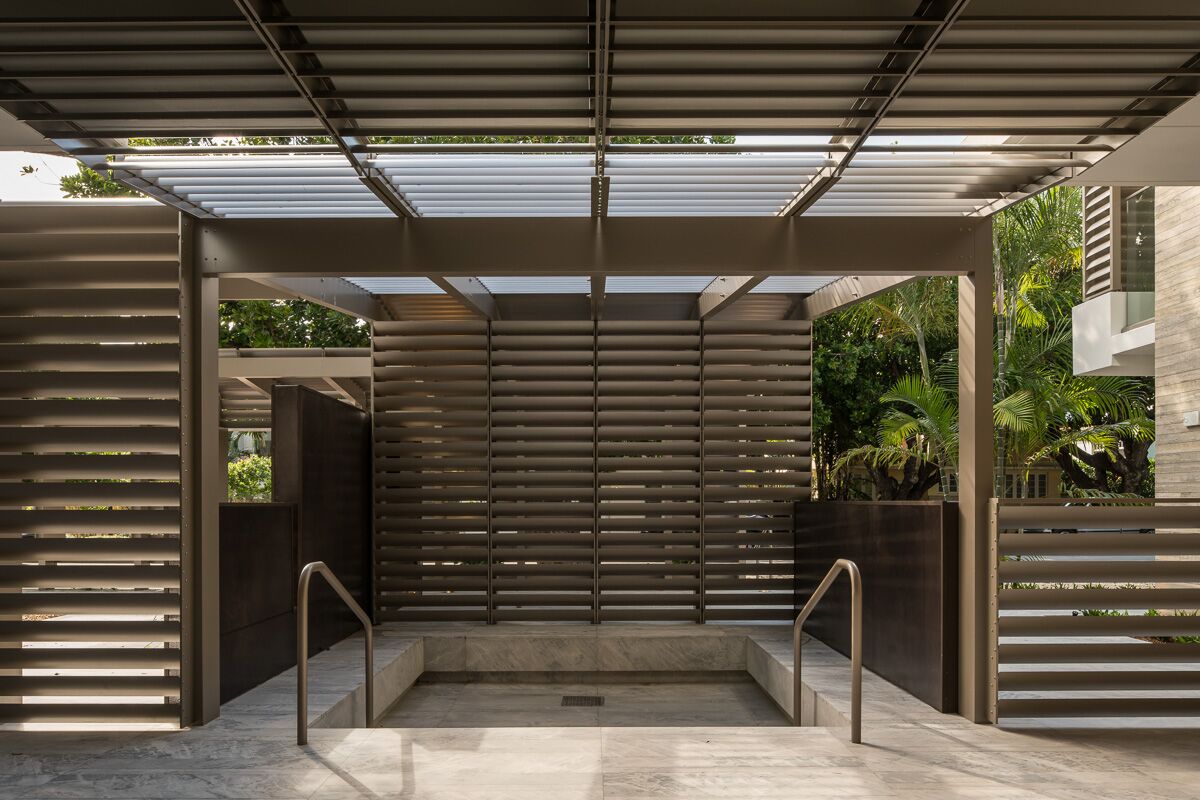An endless coastline, rich heritage and spirit of imagination converge in Florida to create the ultimate luxury lifestyle.
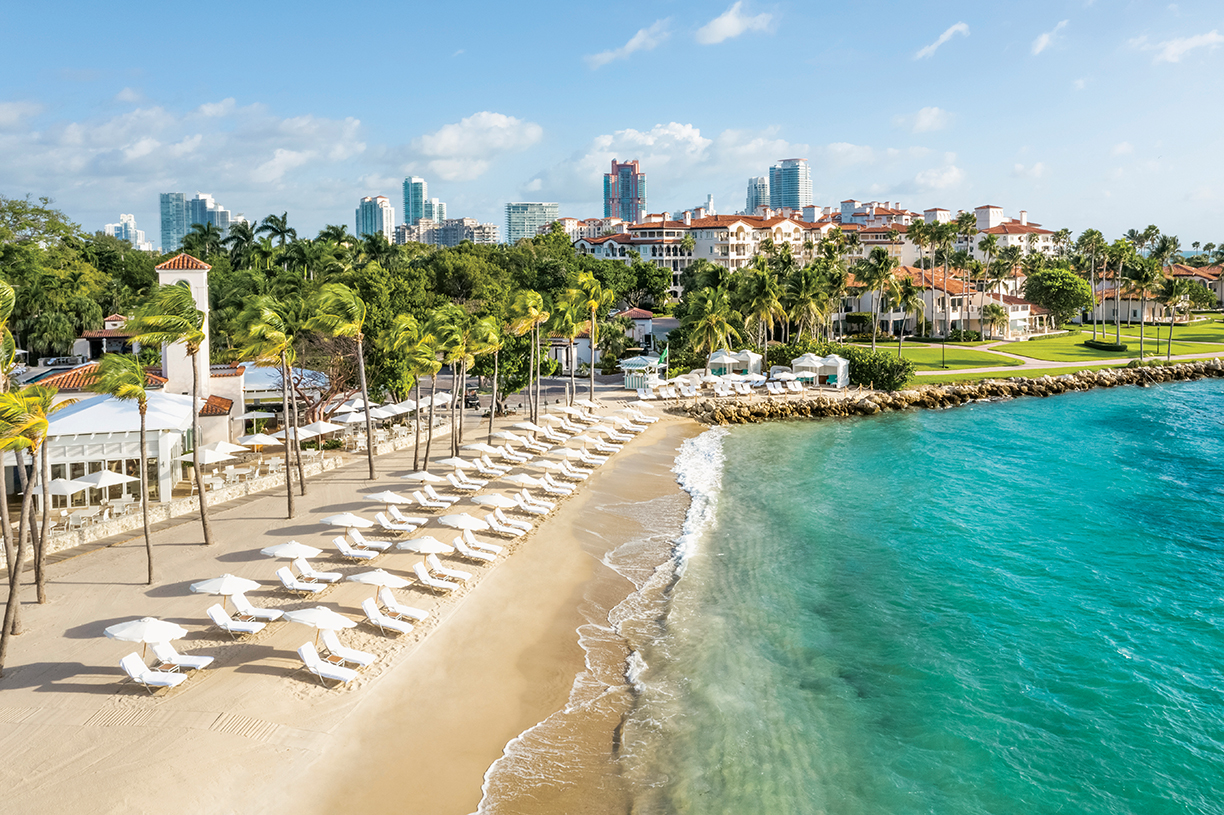
Photo courtesy of Fisherland Club
Fisher Island Club
Florida is a kaleidoscope of iconic images, from signature white-sand beaches and championship golf to Miami’s seductive skyline or theme parks encompassing much more than simply a Magic Kingdom. The entire world convenes on this alluring peninsula for every imaginable recreational experience, and its elite residents enjoy unparalleled luxury.
Florida cannot be defined by a single place or attitude, as its communities represent an incredible spectrum of physical and cultural diversity. Some feel a bit like Savannah or Biloxi, others more spiritually akin to Havana, San Juan or Brooklyn with traditions, music and aromas to match the accents. The fourth-generation Pensacola fisherman and the South Beach fashion designer who recently emigrated from Brazil contribute equally to the state’s personality.
Beachfront
With its 1,350 miles of coastline, luxury residential and hospitality developers find Florida irresistible. South Florida, where the Atlantic Coast is almost continuously developed from Miami to Palm Beach, receives the most attention, but beautiful beaches are also found in less congested areas.
Ideal for catching rays are Clearwater Beach outside Tampa and Atlantic Beach near Jacksonville, both offering wide expanses of white sand. The Space Coast’s Cocoa Beach is favored by surfers, while the dune-swept beaches of Amelia Island attract bird-watchers. The Ritz-Carlton Amelia Island is preferred by amateur ornithologists seeking maximum comfort.
Florida’s Panhandle, whose oceanfront is appropriately referred to as the Emerald Coast, features uncrowded beaches with sugar-white sand. “Distinctly more Southern than South Beach, the area is a throwback to the uncluttered and carefree beach lifestyle of years past,” reports David Merryman, manager of a premier boutique hotel called The Pearl, whose Rosemary Beach locale is reminiscent of New Orleans’ French Quarter.
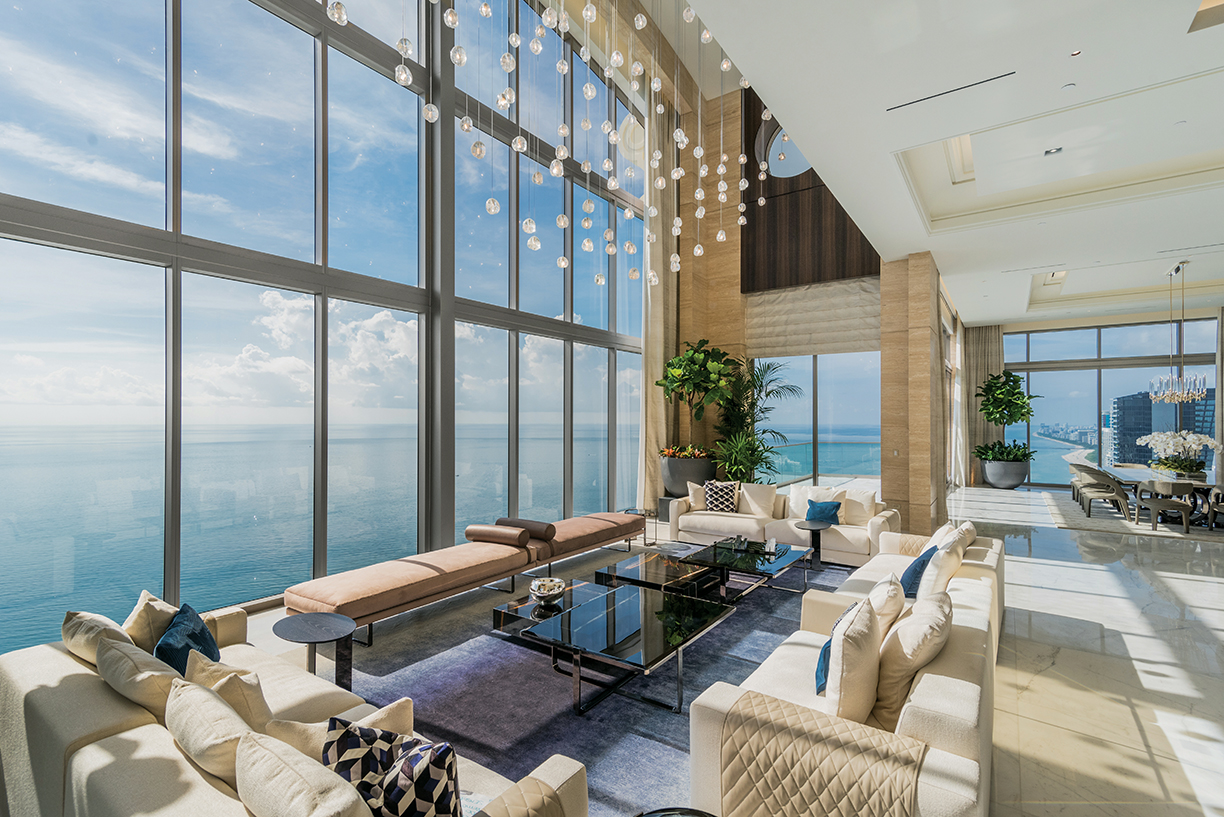
Photo courtesy of Venjhamin Reyes
The Penthouse at The Mansions at Acqualina
Tee Time
It is impossible to overstate the significance of golf to Floridian culture and economics. The game is almost a religion here, despite competition from major league and high-profile university teams, not to mention watersports. Golf generates $11 billion annually to Florida’s economy, a figure surpassing the state’s portfolio of theme parks. With approximately 1,250 courses, Florida offers more opportunities for duffers than any other state, while touring professionals are attracted to the climate, amenities and absence of state income tax.
Based in Palm Beach Gardens, PGA legend Jack Nicklaus is nearly as dominant in golf course design and development as he was on the links at the height of his career. The Golden Bear has designed courses throughout Florida, including King & Bear in St. Augustine, a collaboration with the late Arnold Palmer. The Bear’s Club in Jupiter features a 40,000-square-foot Tuscan-style clubhouse and $10 million estates line its fairways. In Naples, Nicklaus rival Greg Norman authored two courses at Tiburón Golf Club, paired with a Ritz-Carlton hotel.
Luxury homeowners on the barrier islands — they trace Florida’s Atlantic Coast like a string of pearls — enjoy access to both championship golf and the water. Because it occupies a small island, the homes surrounding South Florida’s Indian Creek Country Club are both waterfront and golf course-adjacent, resulting in prices pushing $30 million. Less pricey is the real estate bordering Juno Beach’s Seminole Golf Club, but its membership is so exclusive it reportedly once turned down Nicklaus himself.
State of Design
While influences are imported from other regions, Florida has developed its own signature style, most conspicuous in its architecture. The charismatic skyline of Miami first gained attention during the opening credits of the iconic 1980s series Miami Vice, and things have only accelerated since.
With flashy postmodern buildings and pastel-hued Art Deco jewels, Miami makes other American cities look gray and unimaginative. Celebrity architects from around the world — Norman Foster, Frank Gehry and Zaha Hadid, to name a few — have contributed to the metro area’s skyline, which some experts consider the greatest design laboratory in the world.
Much of Miami’s world-class architecture is driven by a competitive luxury real estate market in which developers use design to sell condos at a premium. In addition to those “starchitects,” residential towers are emblazoned with luxury brands — Aston Martin and Porsche from the automotive world, Armani and Fendi from the fashion world — to increase cachet value. Then-chairman/CEO Pietro Beccari stated at the project launch, “It fully expresses the codes, history and savoir faire that characterize Fendi.”
Further honoring that creative spirit is the 18-block Miami Design District that combines luxury home furnishings (e.g. Bulthaup, Poltrona Frau) with legendary fashion labels Cartier, Versace and Hermès, as well as chic restaurants and the Institute of Contemporary Art’s sleek new digs. The Gulf Coast city of St. Petersburg has created multiple districts to promote local artists and artisans.
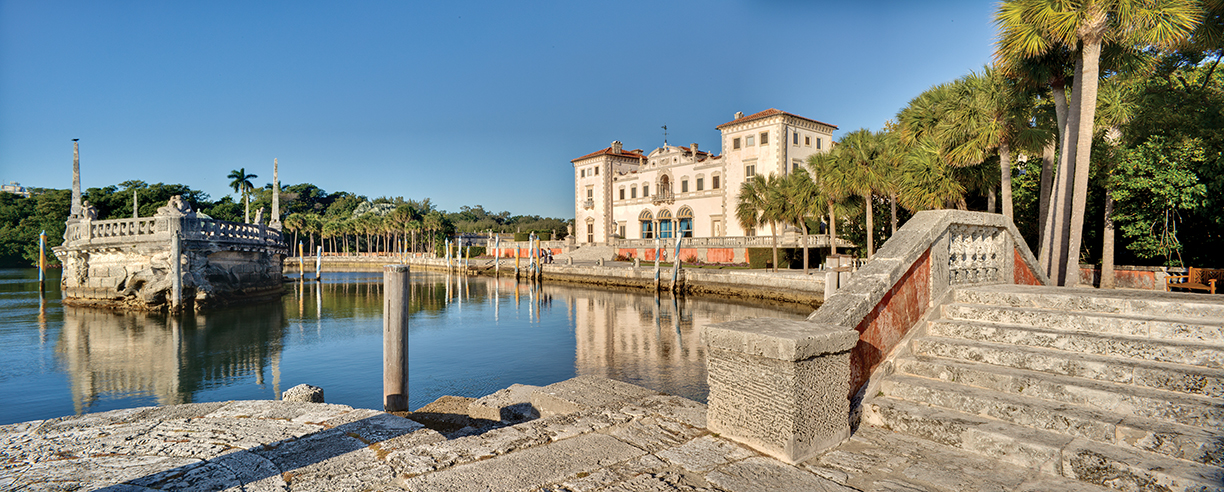
Photo courtesy of Bill Sumner
Vizcaya Museum & Gardens on Biscayne Bay
Extended Stay
Demand for luxury accommodations has fueled massive investments by premier hospitality brands, including a dozen-plus Ritz-Carlton properties throughout Florida. The Fontainebleau, an iconic landmark in Miami Beach since its debut in 1954, has been reimagined as a trendy, Vegas-style property for a new generation. More laid-back is Little Palm Island Resort & Spa on Little Torch Key, which will soon reopen after Hurricane Irma shuttered it for two-and-a-half years. Pat Colee, founding owner of Noble House Hotels & Resorts, states, “This restoration has been a true labor of love and we believe we’ve maintained the authentic character of Little Palm while ushering in added amenities.”
Historic and stately are The Breakers in Palm Beach, a perennial high society retreat, and Miami’s Fisher Island Club Hotel & Resort, a former Vanderbilt estate located in America’s wealthiest ZIP code, a seven-minute ferry ride from the mainland. CEO Bernard Lackner says of the intimate hotel with private club privileges,
“One of the few true private island sanctuaries, Fisher Island offers a lifestyle rich in leisure and recreational activities, yet just minutes from Miami’s world-class commercial, cultural and culinary offerings.”
In Florida, luxury hospitality companies have experimented with their branding of condominiums, an increasingly popular trend. Fort Lauderdale, once famous for spring break, is the site of a glitzy Four Seasons Private Residences where a 3,965-square-foot unit commands $8.9 million. “Four Seasons Fort Lauderdale has captivated buyers with its beautiful, high-class design and comprehensive lifestyle experience in the yachting capital of the world,” states Nadim Ashi, founder of project developer Fort Partners.
The Acqualina Resort & Spa in Sunny Isles Beach, one of Greater Miami’s most exclusive hotels, offers luxury residences at the Mansions at Acqualina. A $38 million penthouse in that tower includes both a Rolls-Royce and Lamborghini.
Arts & Culture
Most surf-and-sun destinations lack robust art scenes, but Florida’s cultural calendar attracts talent from around the globe. Even laid-back locales offer engaging opportunities such as Coral Springs Museum of Art near Pompano Beach, Dalí Museum in St. Petersburg and the Ernest Hemingway House in Key West. “Culture Builds Florida” is a statewide arts campaign designed to promote these assets.
Art Basel is one of the world’s most prestigious art shows (and celebrity scenes), earning Miami the international stature usually reserved for much larger cities. Year-round, Miami offers the Pérez Art Museum Miami (PAMM) and the stunning Vizcaya Museum & Gardens on Biscayne Bay while performing arts enthusiasts gather at the César Pelli-designed Adrienne Arsht Center or Gehry-designed New World Center.
Tampa’s Straz Center — it is the largest performing arts venue in the state — has been a catalyst for downtown development. “The slogan ‘Culture Builds Florida’ is true and true for us in the Tampa Bay area as well,” reports Judith Lisi, president & CEO of the Straz Center. “The arts renaissance throughout Florida reflects a statewide sense of wanting more authentic, more alive experiences in local communities,” she says.
Photo courtesy of Bazaar Photo © 2013 Ryan Forbes
The Bazaar on South Beach
Culinary Clout
With multiple cultures converging in a resort setting, it should be no surprise that the state’s culinary scene is diverse and imaginative. Pioneering chef/activist José Andrés draws inspiration from many sources at The Bazaar South Beach, incorporating foie gras into an elegant riff on Cuban coffee or winking at the Big Apple with a sophisticated, artfully presented interpretation of bagels and lox.
“Another day, another country,” is how Anthony Bourdain once described Miami, citing flavors from Africa, across the Caribbean and throughout Latin America. Florida is a Southern state, so a satisfying bowl of shrimp and grits is never far away, and regardless of cuisine, chefs proudly showcase the bounty of Florida’s farmers, ranchers and fishermen.
The food hall craze has arrived in Florida, with Heights Public Market occupying a former streetcar facility in Tampa and the 50,000-square-foot Central Fare part of a six-block development in Miami incorporating a hub for high-speed Virgin Trains. Those trains are intended to make it easier for Floridians to traverse their state, akin to Europeans whisking through the French countryside on the high-speed TGV. In Orlando, a future Virgin destination, dining options include Bull & Bear, an elegant steakhouse at the Waldorf Astoria, and acclaimed Luma on Park.
Celebrity chefs like Daniel Boulud, Jean-Georges Vongerichten and Michael Mina are flocking to Florida. Joining them is New York’s Michelin-starred John Fraser, who is bringing The Loyal, his American brasserie concept, to an ambitious new development in Miami. “Esplanade at Aventura felt like the perfect fit because they’re creating an approachable upscale culinary experience that not only captures the essence of what I try to do, but also allows me to present my craft to an entirely new audience,” reports Fraser.
The Aventura Mall was already one of the premier shopping/dining destinations in Miami, and the adjoining Esplanade demonstrates the confidence its developer, Seritage Growth Properties, has in the local economy. “Esplanade’s exciting and diverse offerings will truly resonate with both the local population and the large number of international visitors in this market,” says Meghan Kruger, senior vice president of leasing for Seritage.
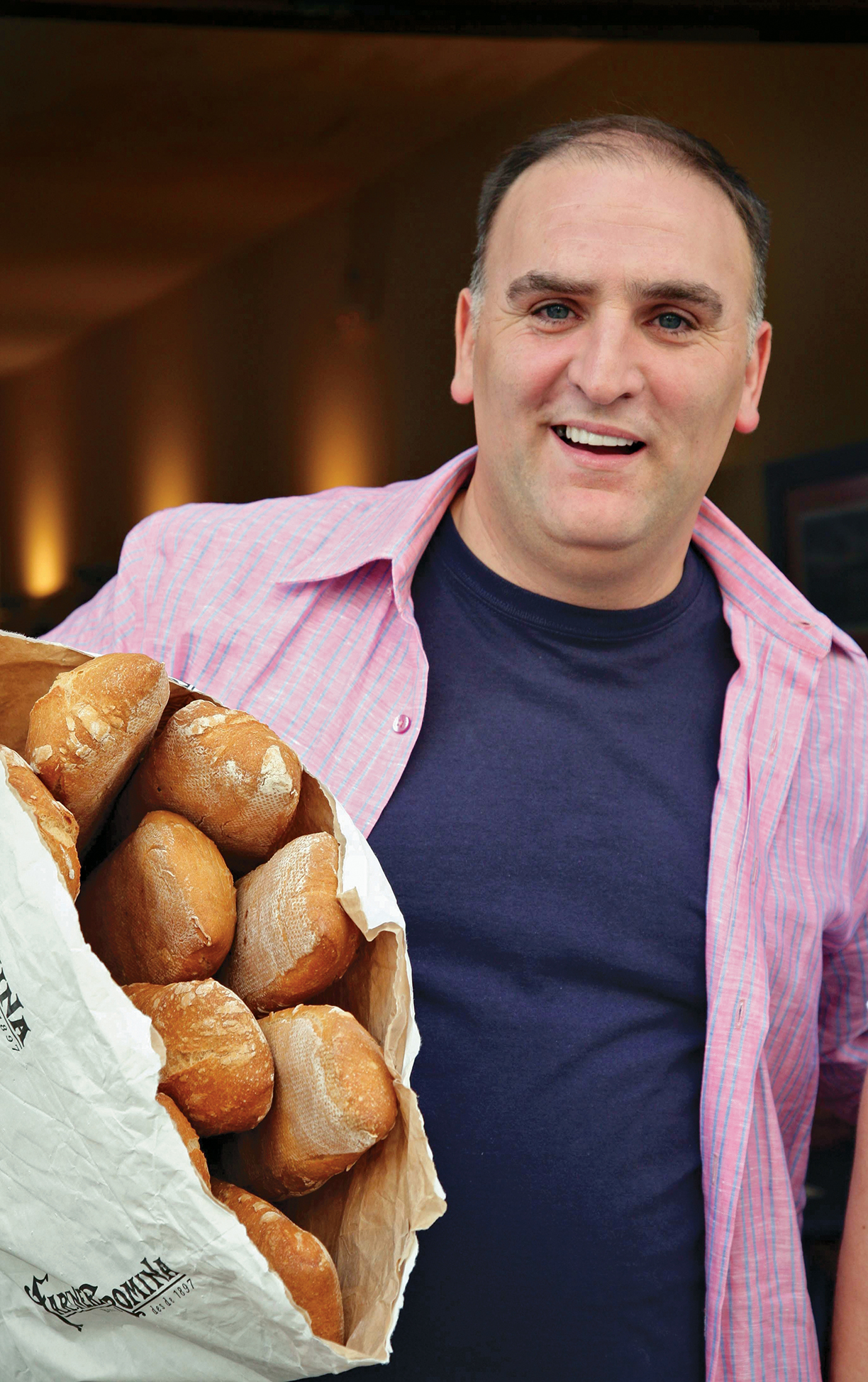
Photo courtesy of José Andrés
José Andrés
Open for Business
Florida is big business, and if the Sunshine State was a nation, its $1 trillion gross domestic product (GDP) would be eclipsed by only 16 countries. Tourism has an annual economic impact of more than $85 billion, but the Florida economy is much more diverse than manicured fairways, white-sand beaches and theme parks.
Aerospace, which arrived with the Space Program, continues to be an economic engine, with aircraft and related parts now being the state’s number one export. With long growing seasons, agriculture contributes even more to the state’s economy than tourism, and it is not just citrus (in fact, Florida’s most exported commodity is meats). Greater Orlando’s economy is no longer dominated by Mickey and Minnie, and its burgeoning technology community contributes $12.5 billion per year to its economy.
Another accelerating business sector statewide is health science, best represented by the world-class Scripps Research Institute in Palm Beach County. Florida’s growing economic influence naturally translates into greater demand for luxury amenities and residences.
This editorial originally appeared in Unique Homes Winter 2020.
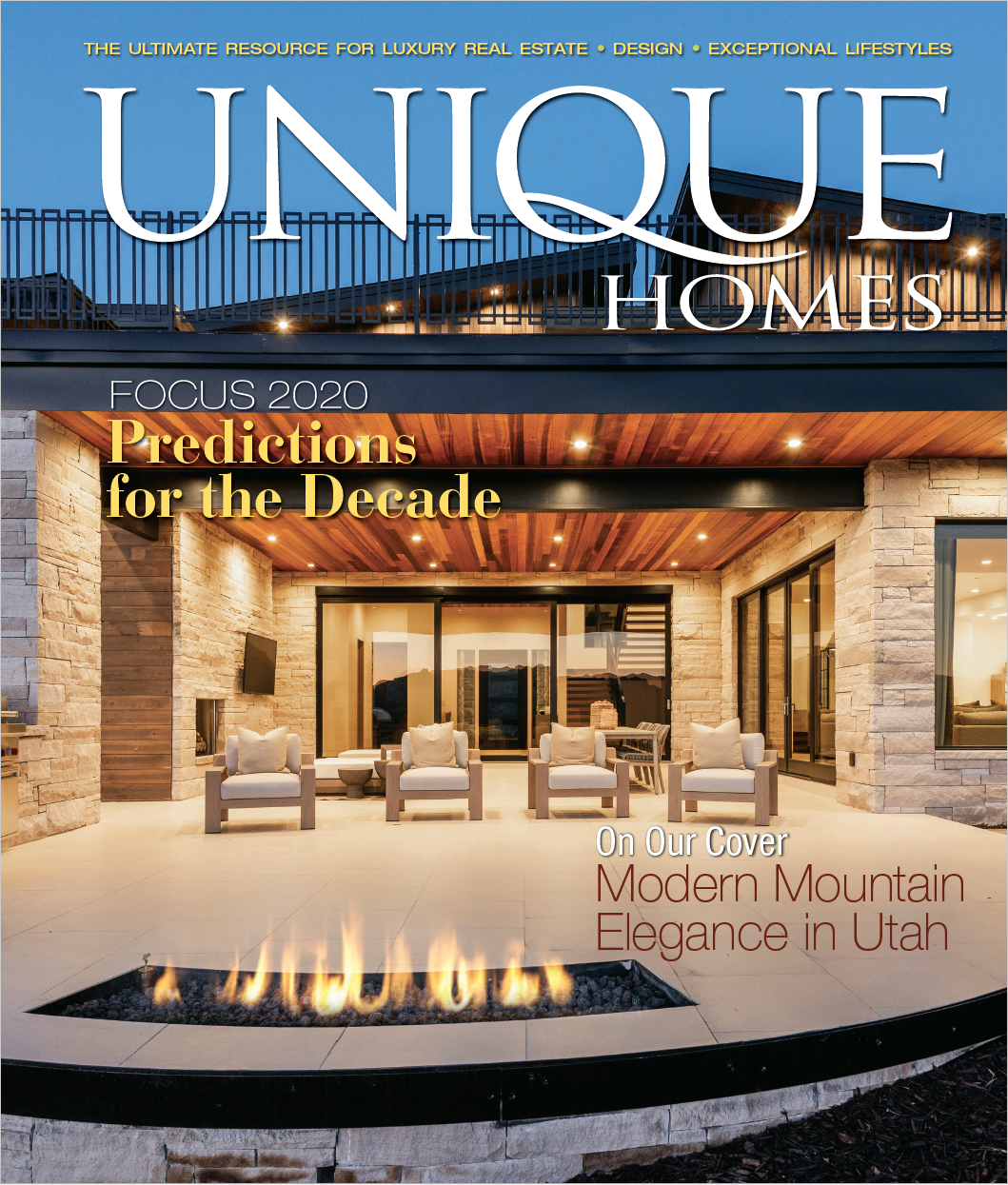

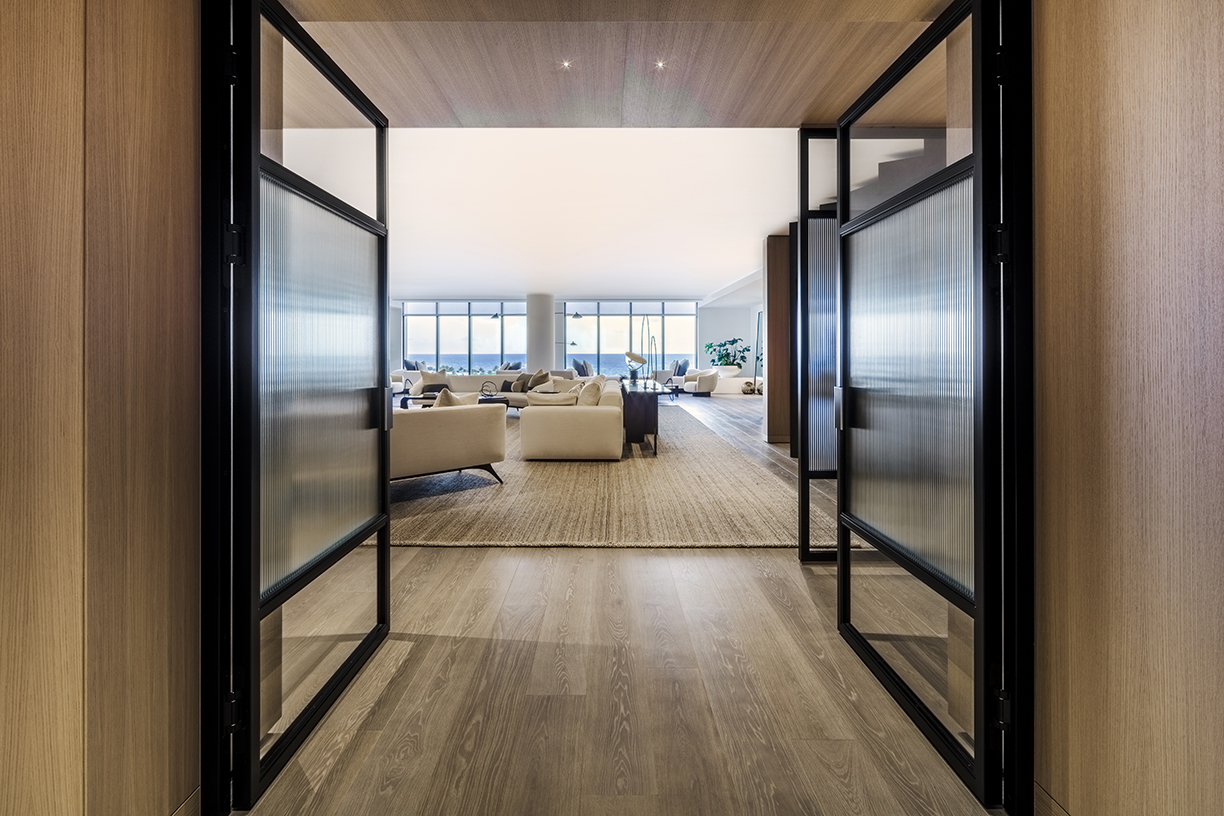
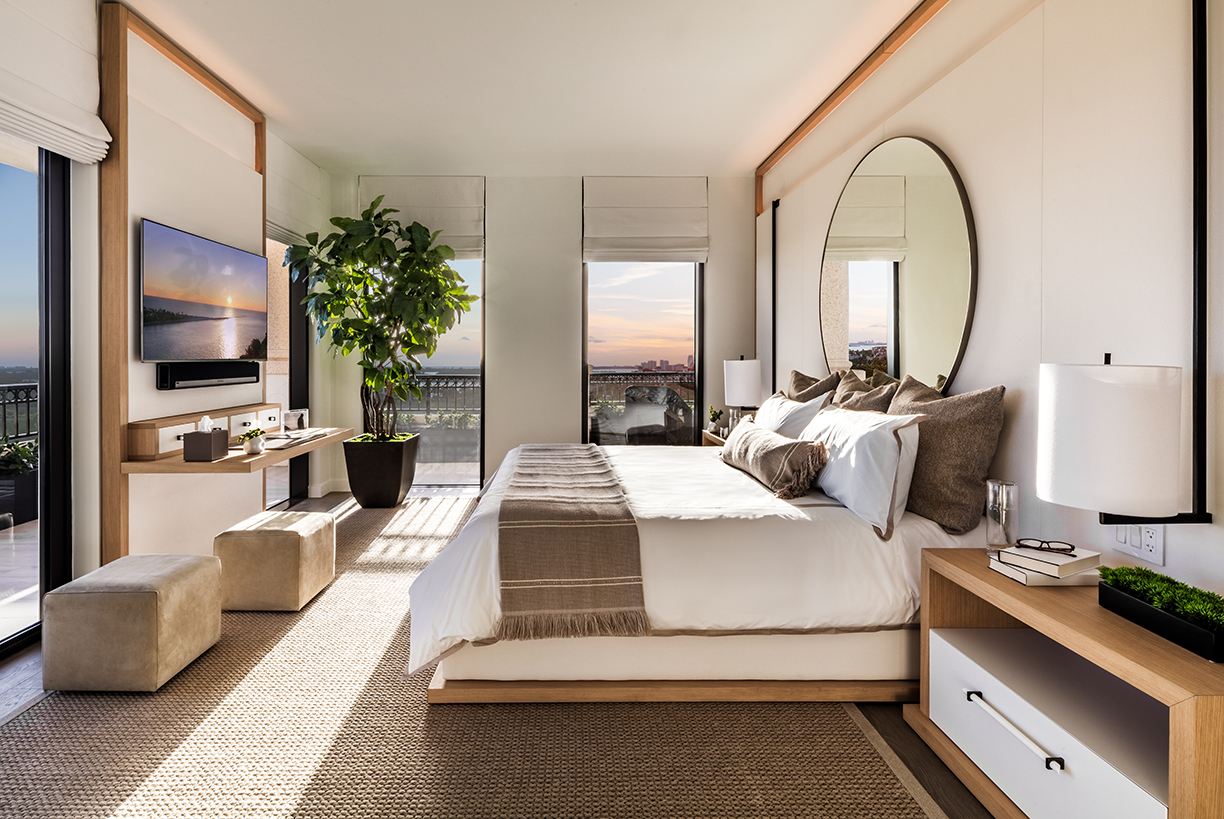
Inspired by its prime location and one-of-a-kind views, this 7,630-square-foot home on Miami Beach’s exclusive Fisher Island merges casual elegance with sophisticated design.
From the elegant, high-end furniture to the neutral color palette, interior designer Sam Robin meticulously crafted this residence at Palazzo Del Sol. We spoke with Robin to learn more about the inspiration behind this home’s unique design.
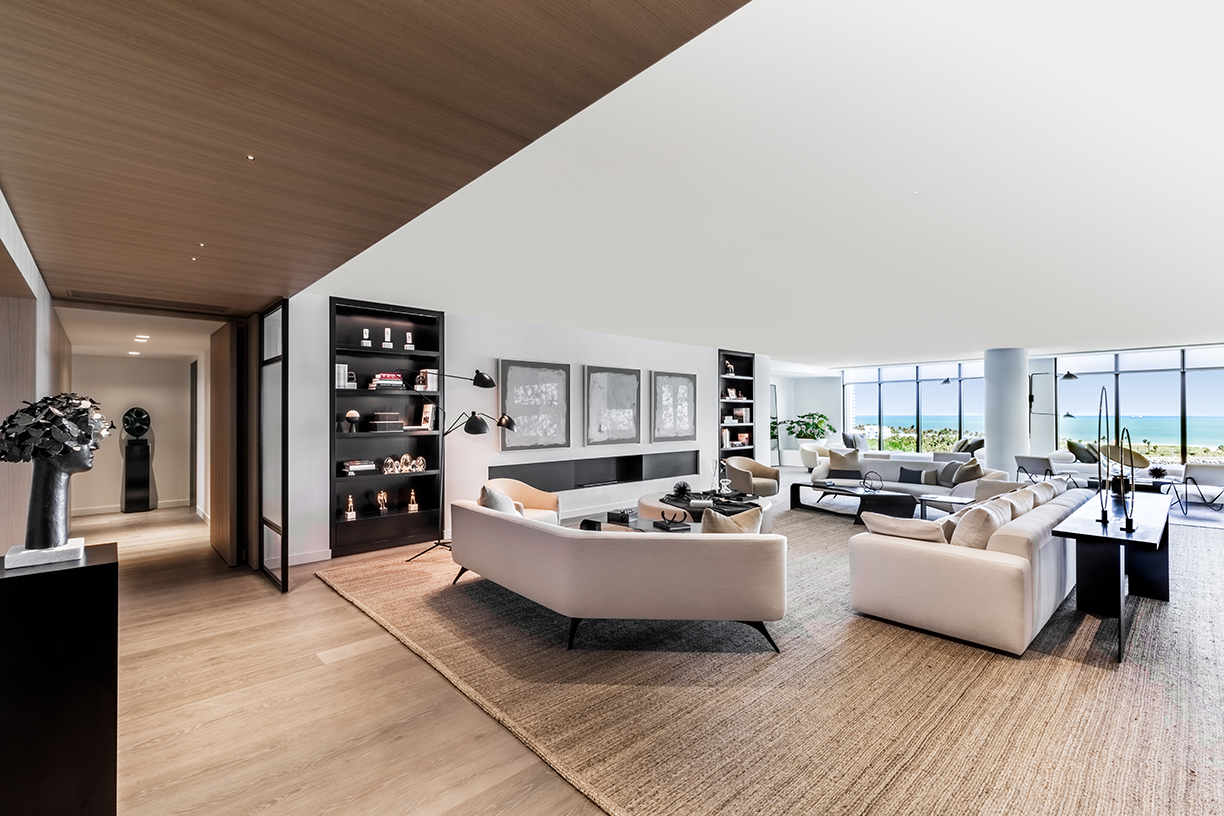
What are some of your favorite standout elements in this space?
The sweeping views of South Beach and Government Cut are absolutely breathtaking, and inspired me to enclose the elevator foyer into a gallery-like entrance. I wanted an intermediate between the building’s public spaces and the residence, and to create an element of surprise as the view is revealed.
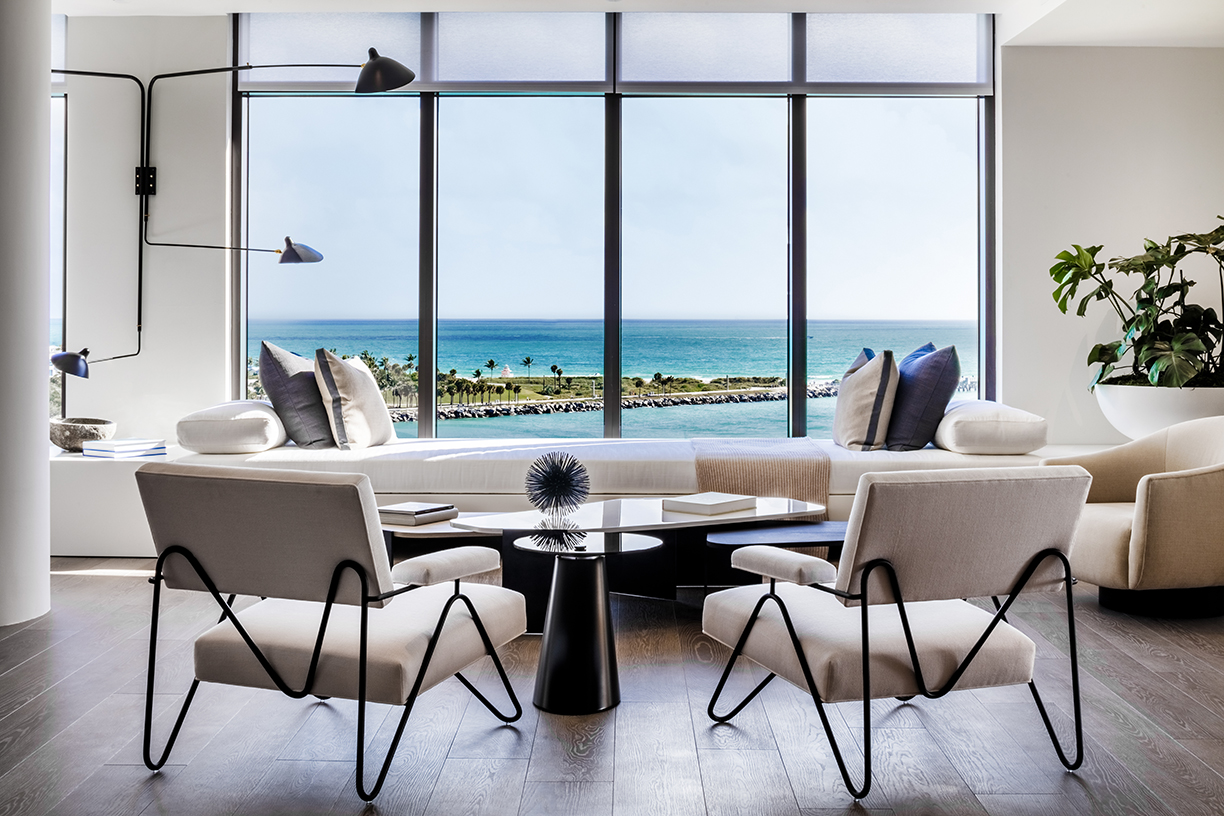
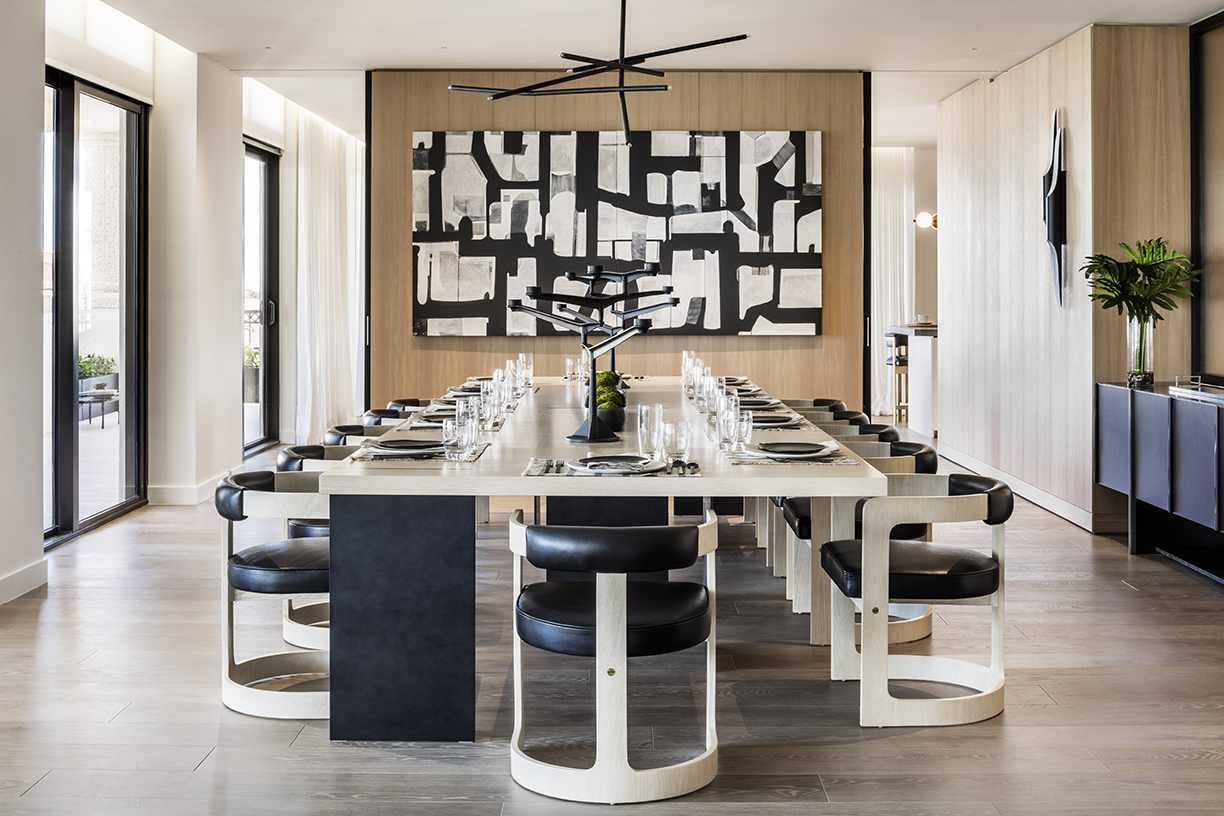
Who do you envision living here?
I pictured someone who is casually elegant and sophisticated who enjoys the beach and leisure of Fisher Island. The homeowner would more than likely host family and friends, so you’ll see several areas designed to accommodate and entertain groups.
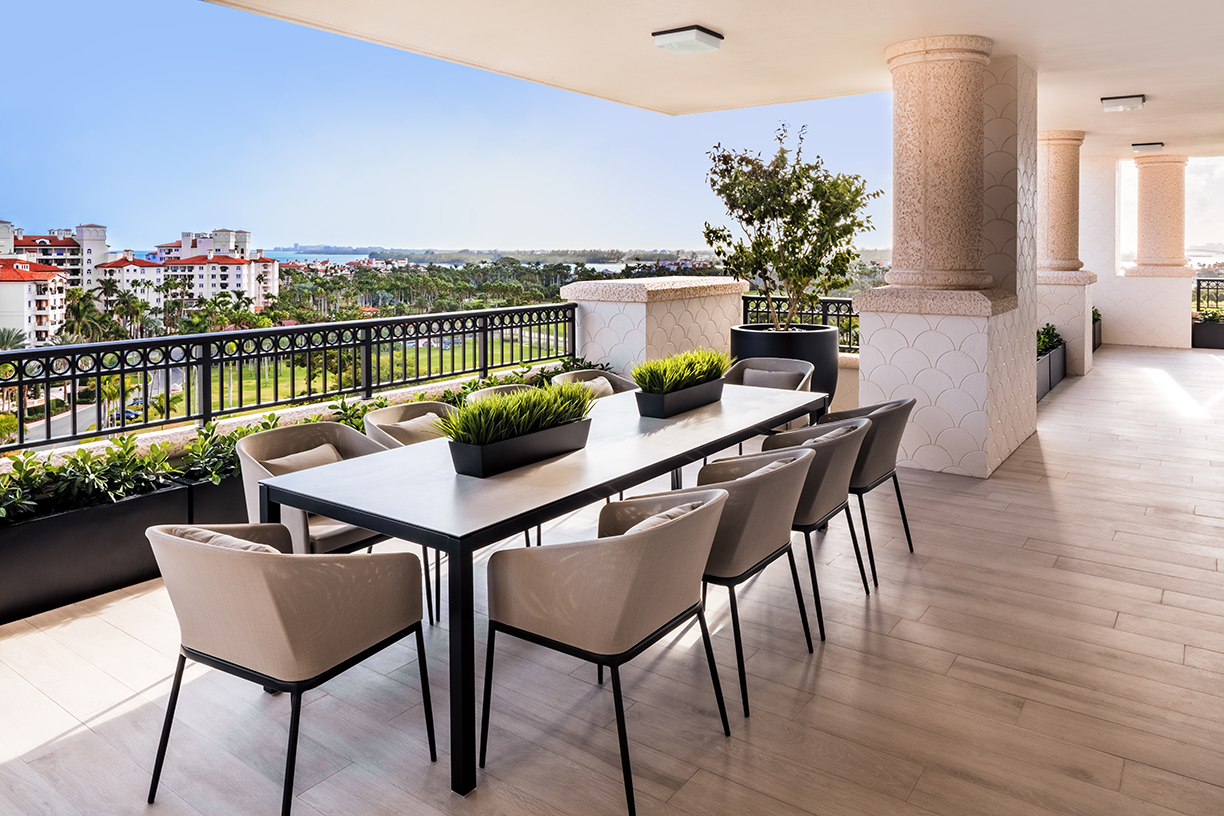
What mood were you hoping to have created in this space?
I stressed comfort, ease-of-care, family and entertaining. The homeowner should feel that they stepped into a space created specifically for them.
Why did you choose this color palette of the home?
The interior palette is light and neutral with contrasting hardware and details for an elegant yet relaxed aesthetic. I focused on creating a sophisticated space with clean lines that felt equally cozy and inviting. The neutral tones help to achieve that, and also help to maximize the views.
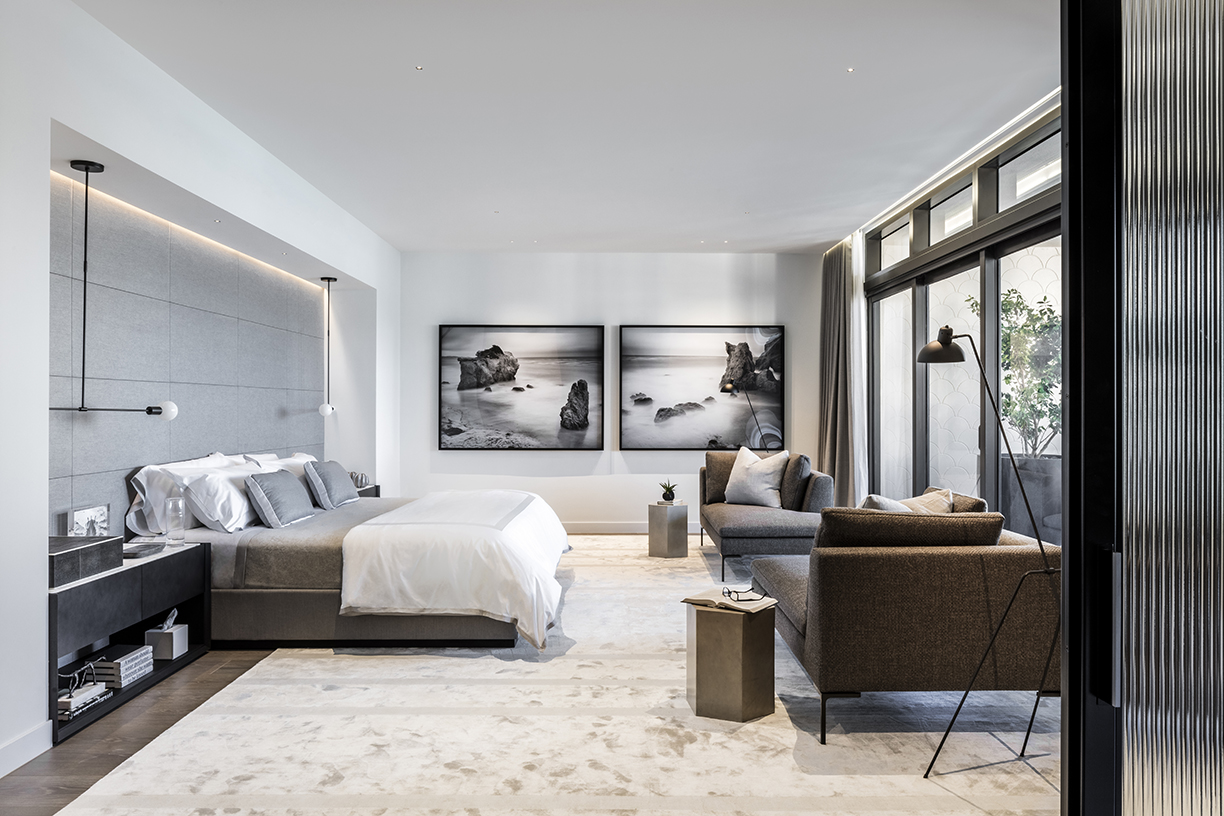
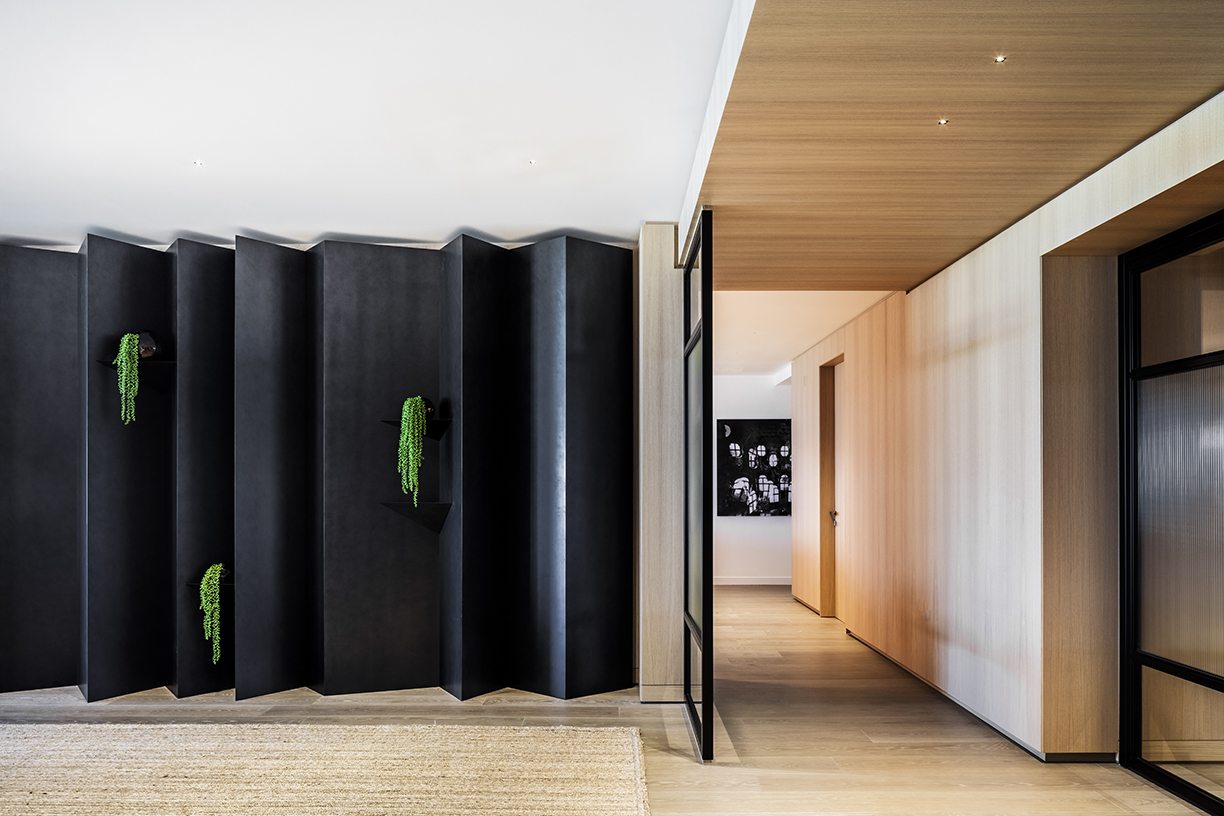
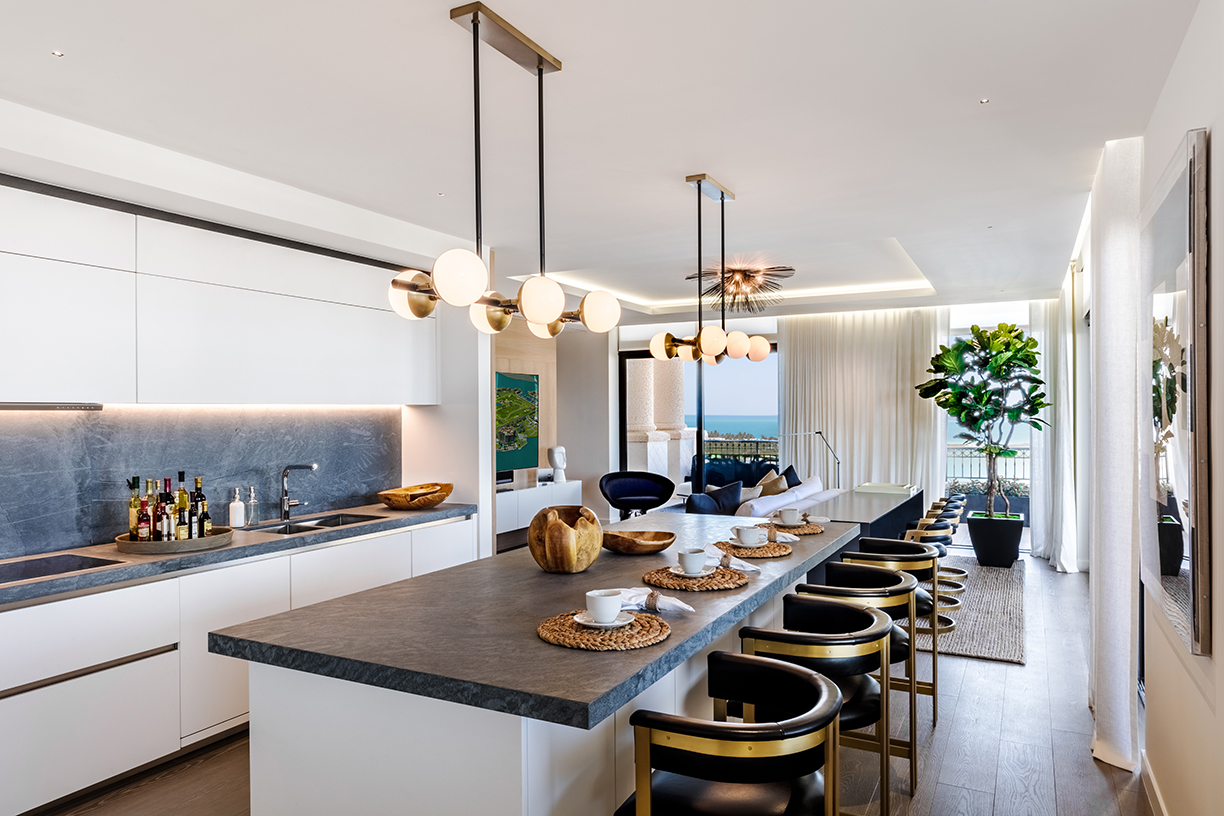
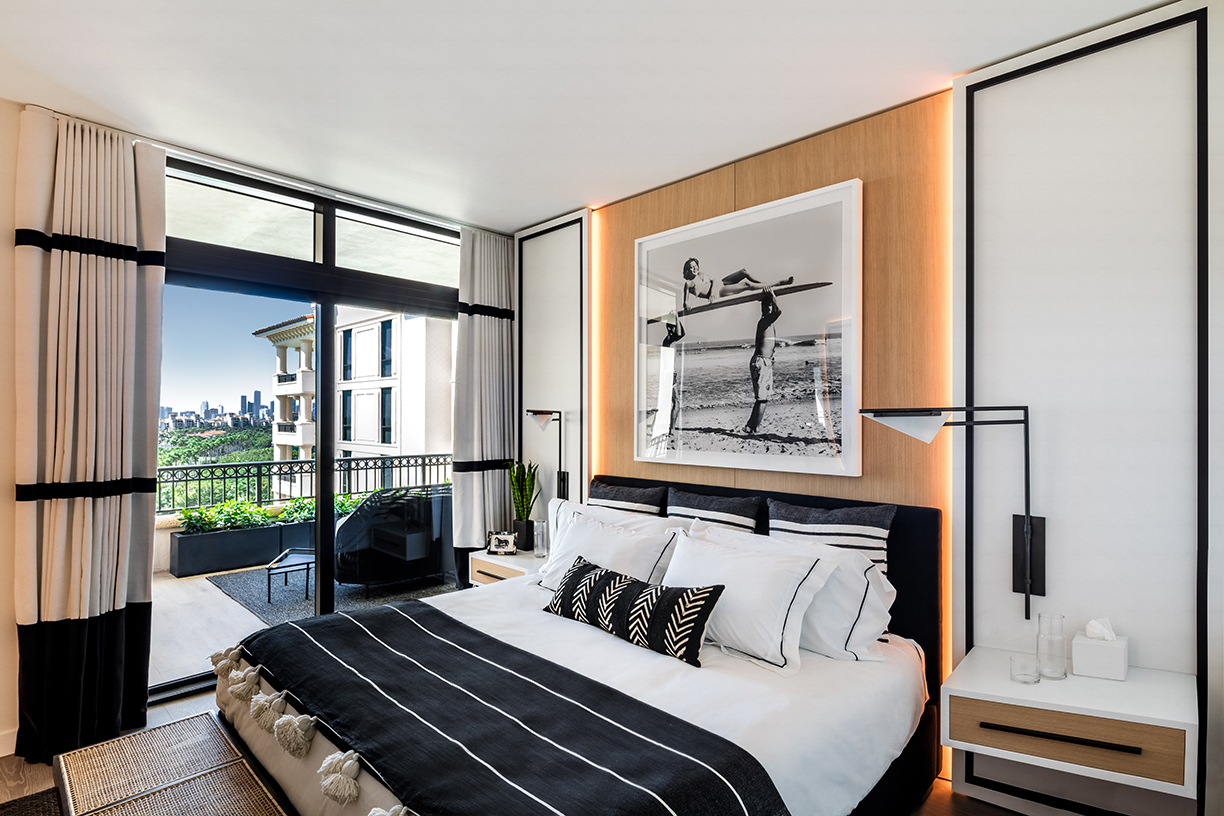
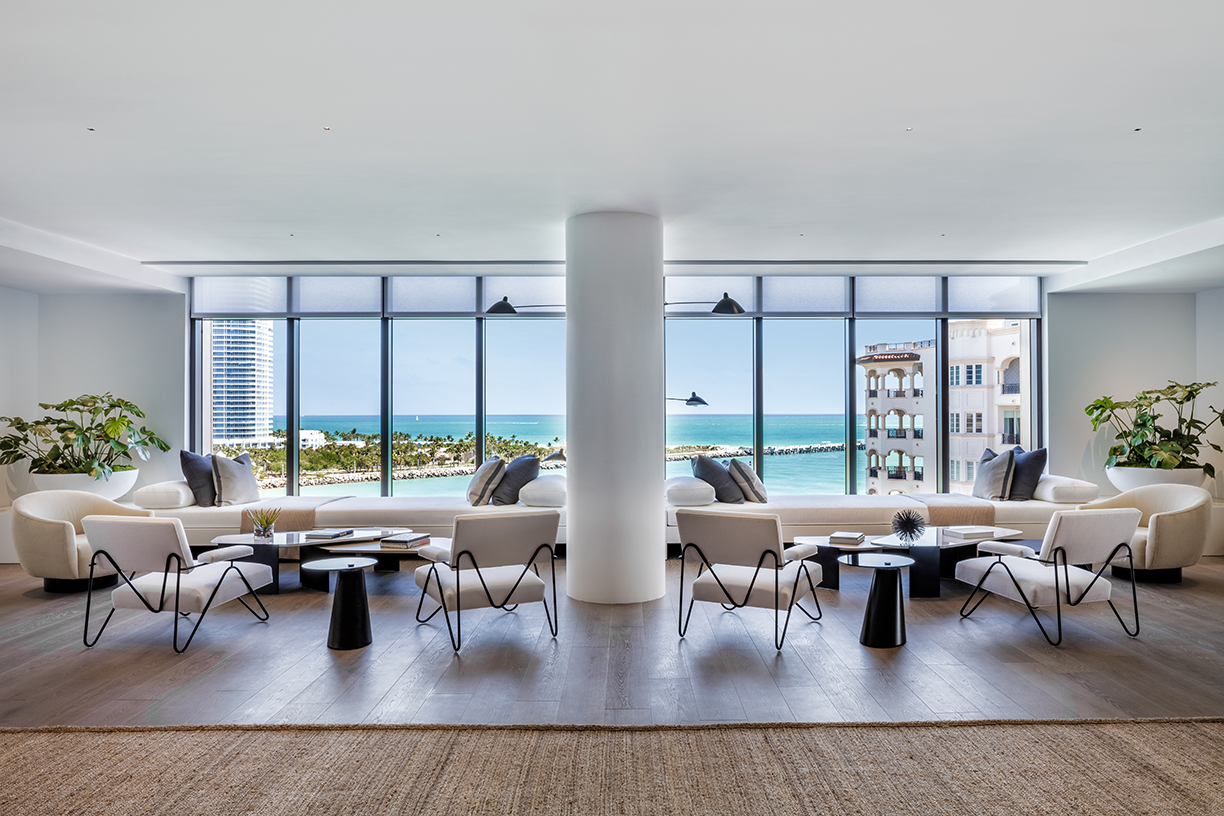
Were you able to bring any natural elements into the home?
In this space, I played on the surrounding environment and nature by incorporating wood in several ways. The walls and floors are covered in bleached white oak. The dining room features leather and cerused wood chairs around a bleached oak table. I also added greenery to the balconies and in corners of several rooms. It’s a subtle technique, but it’s effective in softening and pulling together large spaces.
Photos courtesy of Kris Tamburello
How did the ocean and city views influence your design?
The ocean inspired the overall ease of the home. When I think waterfront, I naturally go for a look that is less buttoned-up. The wraparound balcony and its oceanfront vistas bring natural light into the home, so we opted for a softer glow with lighting throughout.
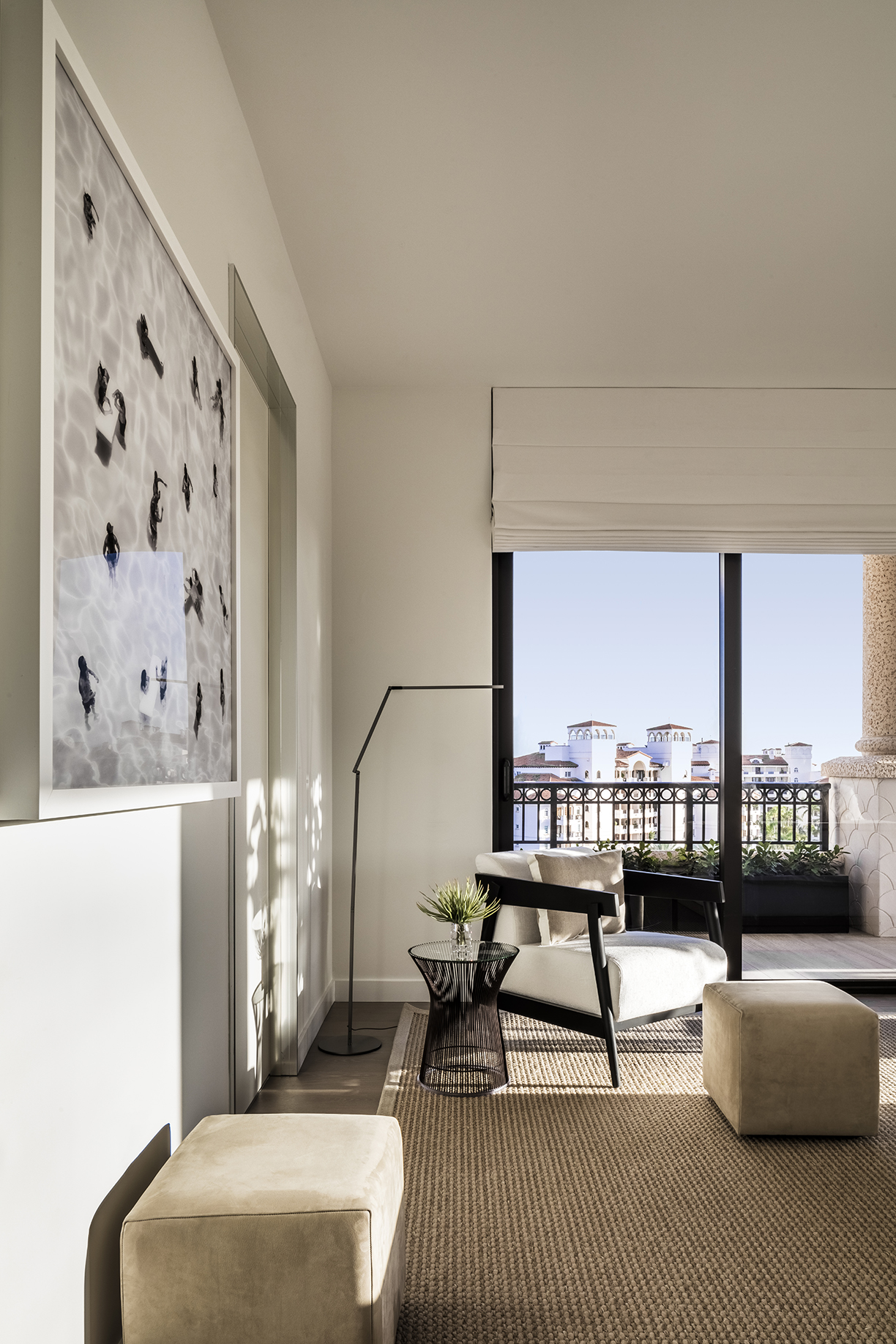
Interior design experts predict that more dramatic kitchens — featuring darker wall colors, cabinets and countertops — will take over 2018.
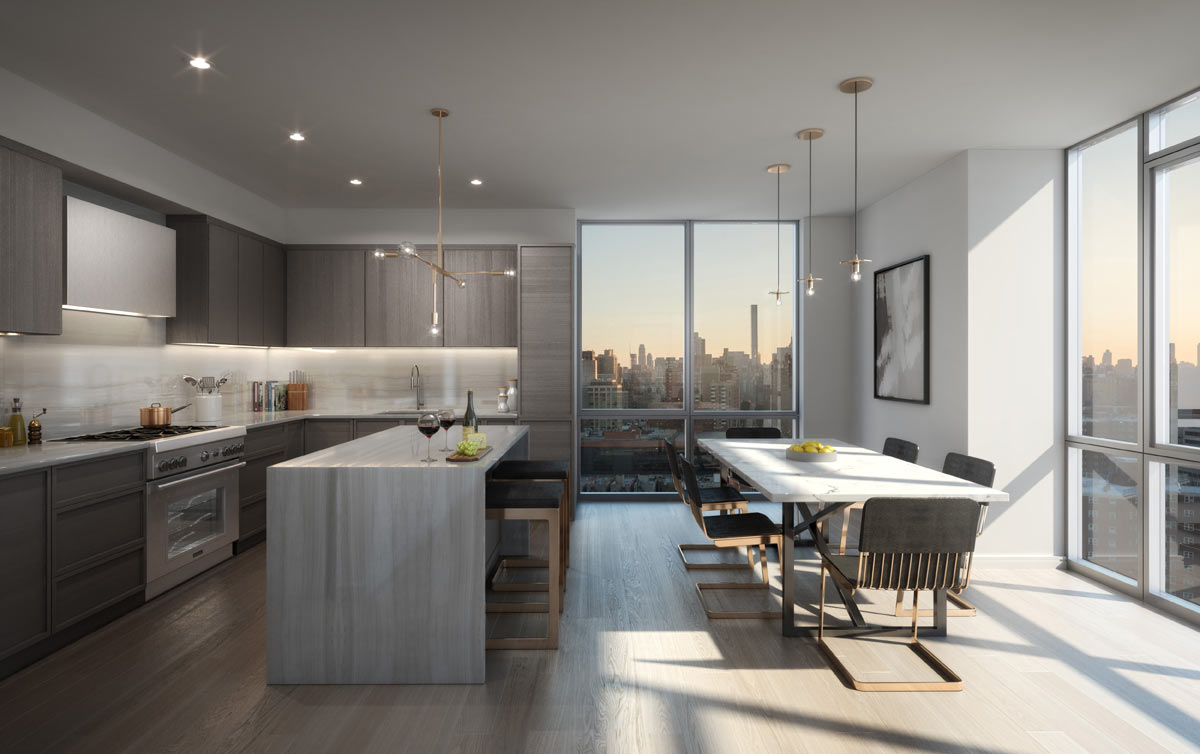
Photo courtesy of Volley
Each year marks a new design trend, especially in kitchens. Dark kitchens are now the luxury seal of approval for home design. Interior design experts quoted in Vogue and ELLE Décor predicted that white kitchens have reached the peak of popularity, and to look for darker, more dramatic kitchens — whether it be the wall color, cabinets and/or countertops.
Below is a list of luxury developments that are already taking note of these dark, moody kitchen design trends:
Interior Designer, Kimberly Peck, masterfully included Italian composite matte black cabinets for the grand, open kitchens at 62-66 North Third Street, a luxury condominium in the heart of Williamsburg. This modern and sleek design element offers residents a moodier industrial living space, which reflects the neighborhood’s ambience.
This is a 19-unit boutique property nestled within Miami Beach’s exclusive South of Fifth neighborhood, featuring spectacular interiors by Thomas Juul-Hansen that are guaranteed to inspire. Each residence is equipped with custom kitchen cabinets and Miele appliances that add a touch of dark contrast to the overly used stark white kitchen palate in Miami Beach. Other features include a built-in bottom mount fridge/freezer, fully integrated dishwasher, espresso machine, convection oven, undercounter wine storage and designer fixtures from Vola and Hansgrohe.
Internationally acclaimed furniture designer Holly Hunt’s first-ever residential development, L ‘Atelier is a 24-residence boutique oceanfront luxury high-rise in Miami Beach. Beautifully crafted Luxury Poliform Italian Kitchens, featuring World-Class Gaggenau Appliances with exquisite dark-colored finishes, L’ Atelier’s kitchens are a modern work of art which showcase this new design trend. Residences will be priced from $3.5 million to $25 million and are scheduled to be completed in 2018.
4. 1 Flatbush
Whitehall Interiors added a dark accent wall to the kitchens in this Downtown Brooklyn apartment to complement the lighter cabinets and countertops, as well as add a bit of drama to the rooms.
The spacious kitchens at this Whitehall Interiors-designed luxury condo in Harlem feature darker gray custom oak wood cabinetry to balance the natural light shining in from the floor-to-ceiling windows and the Athens Silver Cream marble backsplash and countertops.
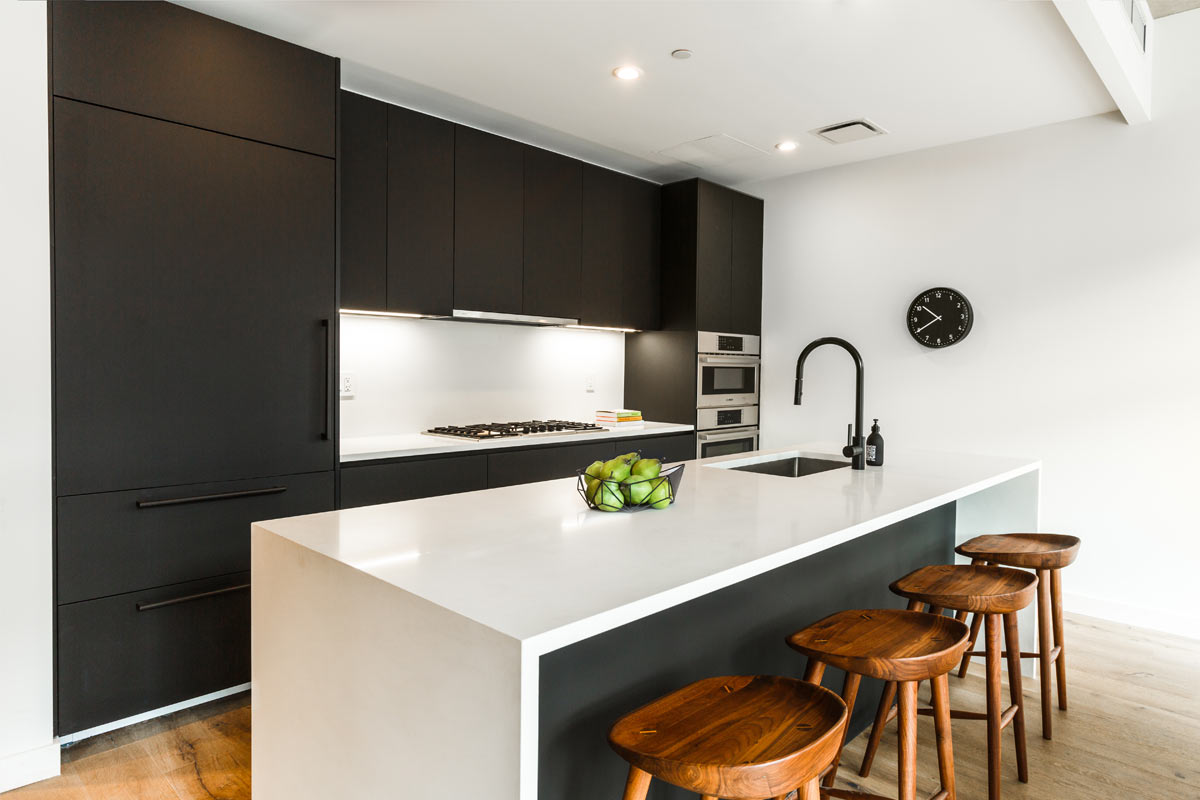
Photo courtesy of MNS
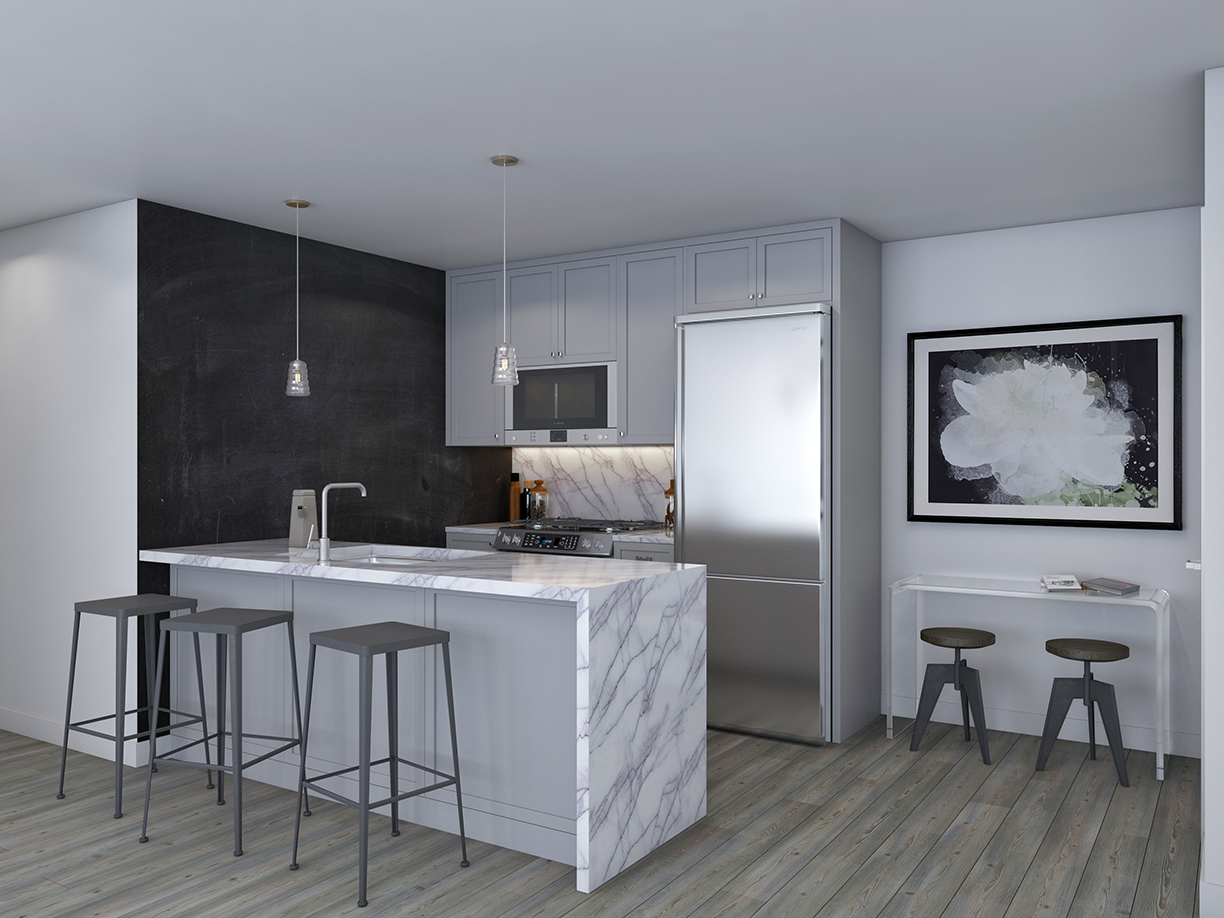
Photo courtesy of MAQE
Louver House — a Miami Beach residential building by award-winning architect Rene Gonzalez and prestigious developer Mast Capital — is finally completed.
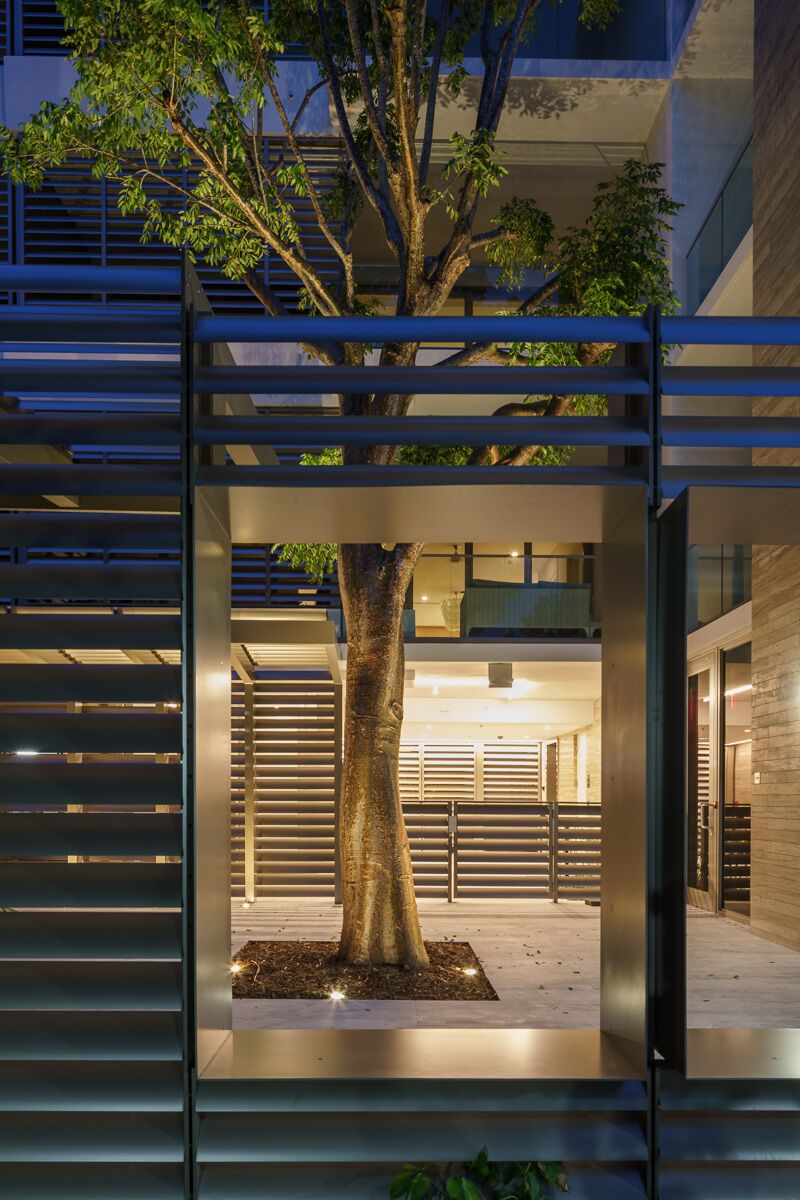
Architect Rene Gonzalez incorporated the South of Fifth community’s distinctive elements, like its lush tree-lined streets and storied past, into the very fabric of the building. He started by preserving the memory of a historic Belvedere bungalow that was once on the Louver House site. In its exact place, he created a louvered bungalow that will be the focal point of the entrance. Mast Capital also brought on artist Michele Oka Doner to create artwork that will hang in the lobby area. The space will be draped with plants from landscape architect Savino & Miller.
Louver House is nestled in the historic South of Fifth Street neighborhood of Miami Beach, a residential area noted for its art deco and mid-century architecture, as well as the enveloping natural landscape of both tropical vegetation and the sand beaches of the Atlantic Ocean. Responding to each of these conditions, the design of this 3-story, 12-unit residential building reinterprets the surrounding historical design typologies in its layout and scale. Vernacular details such as an emphasis on horizontality and art deco “eyebrows” are expressed and translated at the building’s edges with planters as well as with the terrace balconies’ slab edges. With prominence given to the building’s corners, Louver House’s terraces also form considered visual compositions as well as functional spaces for each unit.
“The architectural design for Louver House has everything to do with the beauty of the building’s surroundings; we wanted to create a substantial and substantive piece of architecture that pays deference to its environment and urban condition,” says architect Rene Gonzalez.
Measured and contemplative, the design of this residential building provides a living experience that responds to the special qualities of the site. Allowing for a balance between solidity, light and air, the façade combines modulated silver travertine feature walls and aluminum louvers. The site of an historic 1920s Belvedere Bungalow that originally sat on the property, Louver House will also dedicate the entry pavilion and a significant portion of the ground floor lobby to reference the original structure.
Establishing an equilibrium between the interior and exterior with garden courtyards, open air spaces and louvered planar surfaces, the design of the building takes the typically centralized interior courtyard space of an art deco design typology and cuts it up, redistributing it evenly throughout the building while maintaining significant portions of the roof and ground floor as open space. While first floor units have private garden entryways, flow-through units on the upper levels are anchored by balconies on the Eastern and Western ends, and have expansive garden terraces that extend from each unit’s living rooms, creating a blurred boundary between indoor and outdoor space.
“We’re excited to finally present Louver House because it has all the key elements buyers are looking for in today’s luxury residential real estate market,” says Camilo Miguel Jr., CEO of Mast Capital. “To us, luxury is about amazing finishes, expansive spaces and the ability to enjoy a sense of privacy. This building offers a unique lifestyle that places residents in one of Miami Beach’s most exciting neighborhoods, but because of its small scale, also serves as an exclusive, family-friendly enclave.”
With only four residences remaining, Louver House will commence closings mid-August. Prices for the remaining residences range from $2.5 million to $3.1 million.
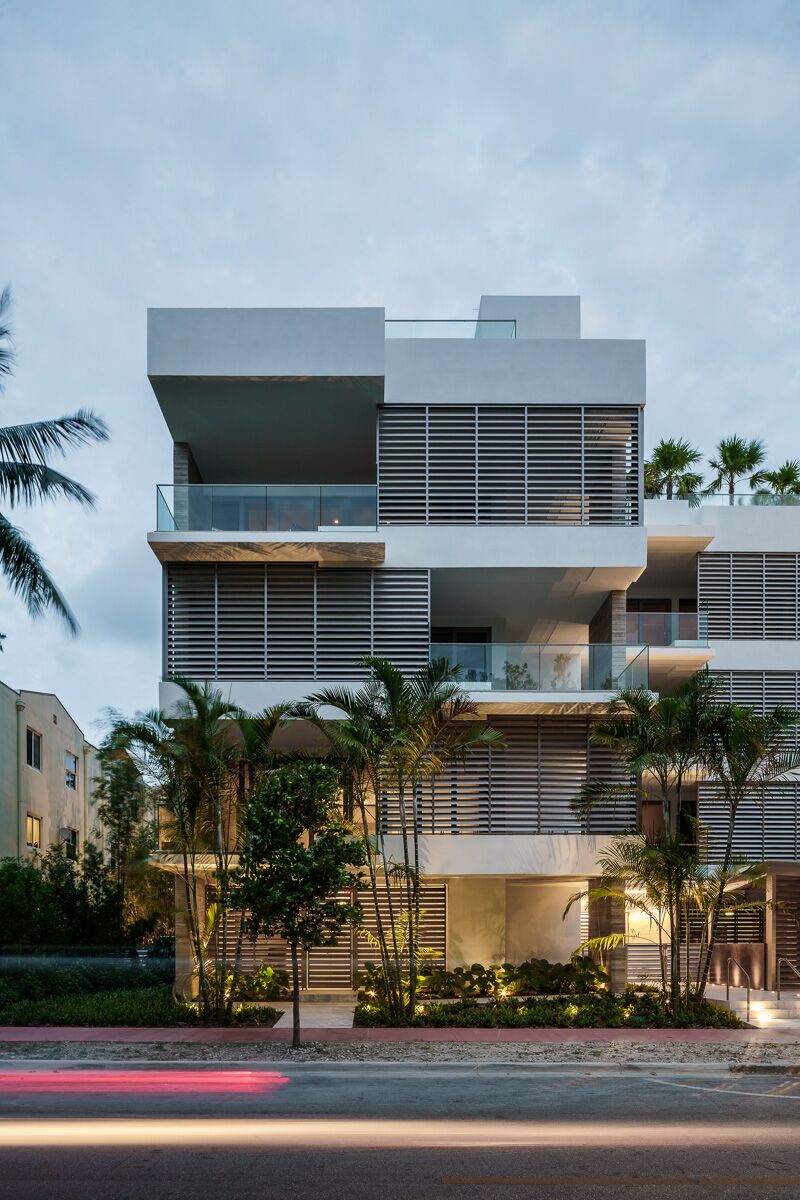
Photos by Michael Stavaridis / Courtesy Rene Gonzalez Architects


